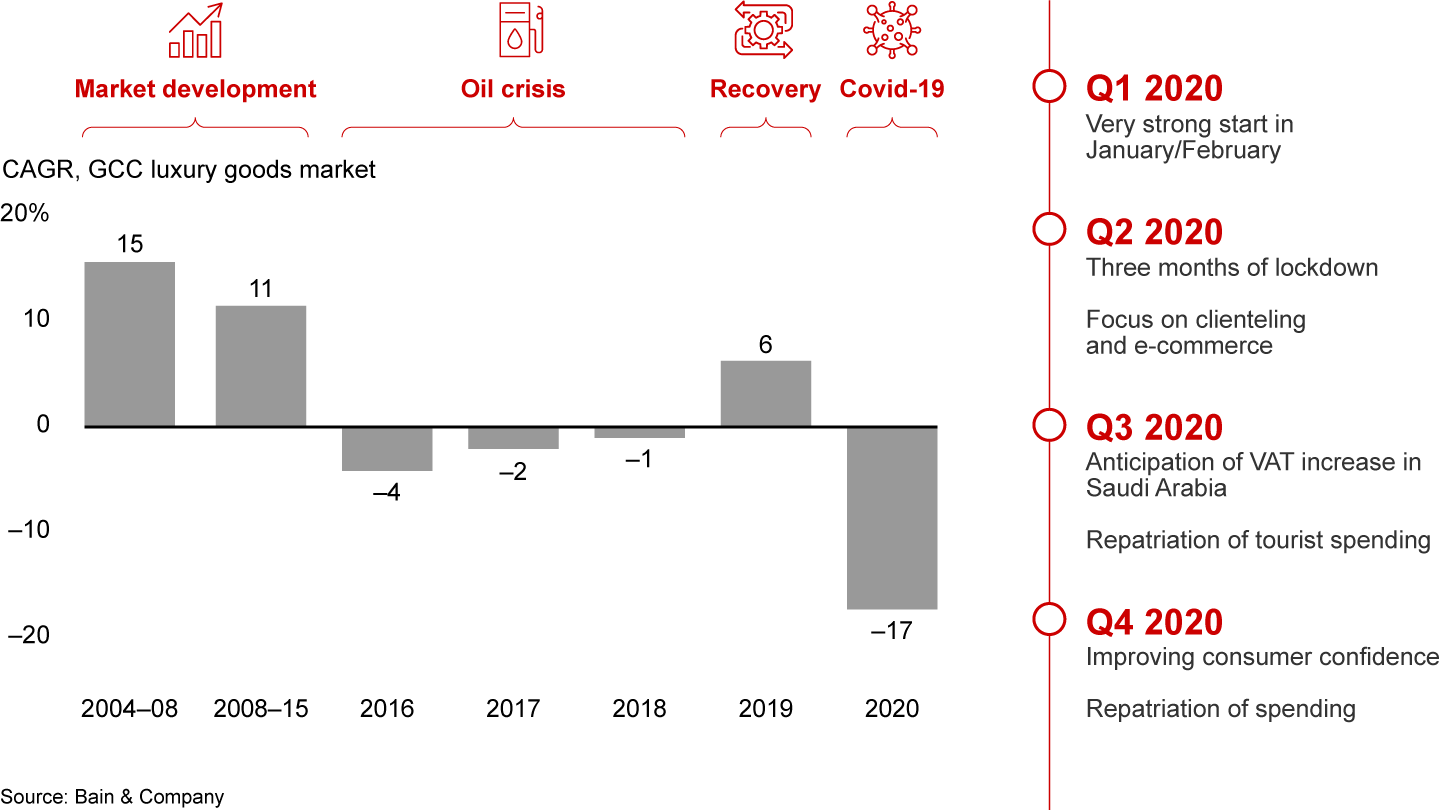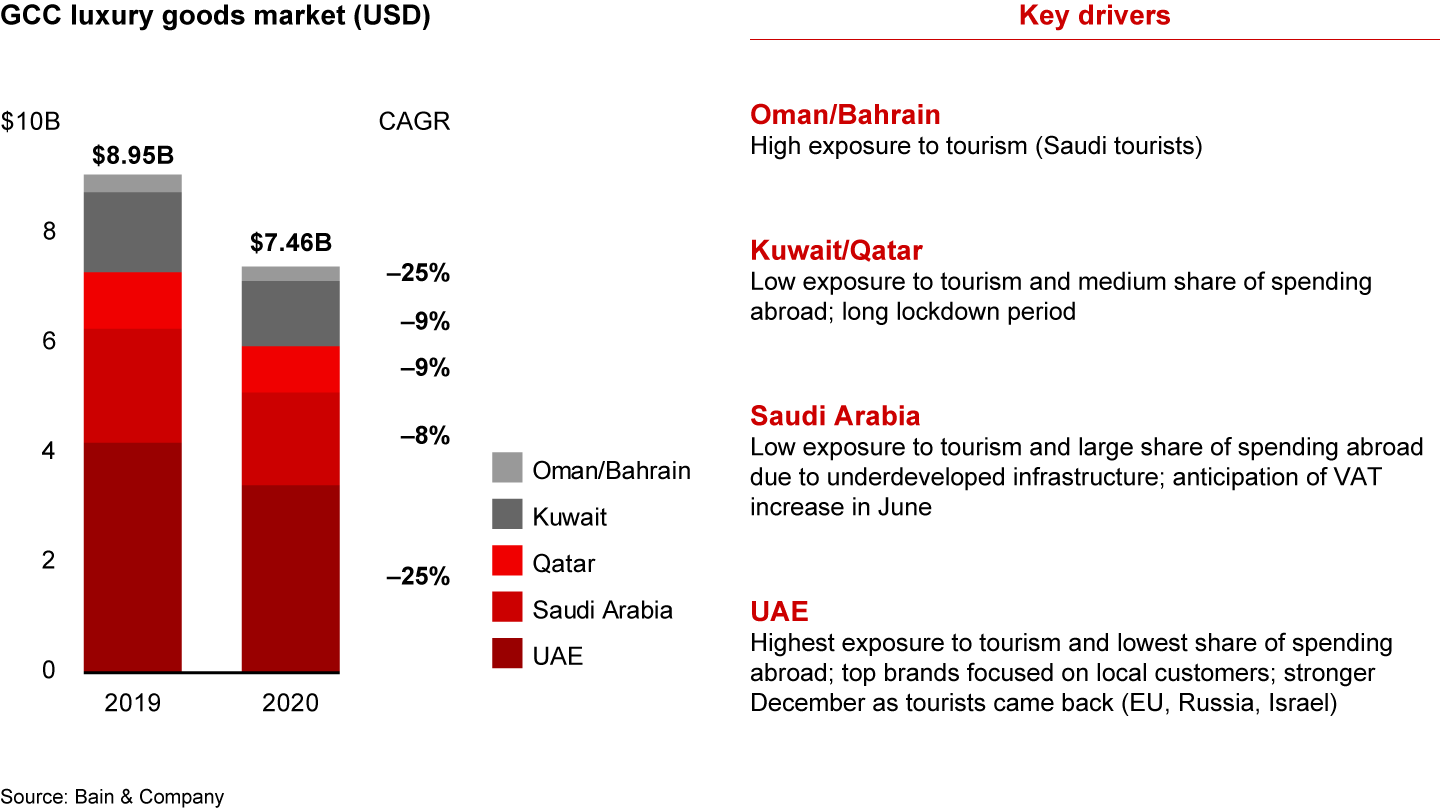Brief

Although the Covid-19 pandemic has taken a toll on the global luxury goods market, its impact on countries, categories, and brands in the Gulf Cooperation Council (GCC) region has varied. The emergence of some positive shopping trends and the ongoing recovery offer hope for a return to relative normalcy in 2021 and into 2022, following a 17% decline in the region’s luxury market in 2020 (see Figure 1).

The GCC luxury goods market dropped to $7.4 billion USD in 2020, with different country dynamics depending on exposure to tourism and repatriation of spending (see Figure 2). Although the decline in tourism hurt the market, GCC nationals (who usually purchase 30% to 40% of their luxury goods outside the region) repatriated spending in their respective countries. Countries with low exposure to tourism, such as Kuwait, Qatar, and Saudi Arabia, did not see such a sharp drop as in the United Arab Emirates (UAE), where the impact was closer to the global average decline of 23% vs. 2019.

Changes in tourism flows had a major effect on the market in 2020 and the early months of 2021. In the UAE especially, where tourists account for as much as 60% of the luxury market, an undeniably large block of spending power was wiped out rapidly by ongoing Covid-19 travel restrictions.
Bain & Company research reveals clear differences in 2020 market dynamics by category.
- Jewelry: The category saw a second-half rebound spurred by local GCC customers, especially in Saudi Arabia, due to weddings, investment buying, and the launch of new collections. Jewelry was the only luxury category to achieve value growth in 2020, albeit just a 1% increase. Spending abroad was fully repatriated, with top brands outperforming and growing their presence in Saudi Arabia.
- Watches: The lack of tourists weighed heavily on this sector, with Swiss watch exports declining 50% in volume and 20% in value.
- Beauty: GCC markets were in line with the global decline partly due to travel retail, with makeup suffering more than fragrance. However, there was one positive effect: The category saw an e-commerce boom as GCC residents headed online to shop the latest trends and launches.
- Fashion: Both tourist and local spending were affected by the shift toward more casual day-to-day apparel. Much like beauty, fashion saw an e-commerce boom, with top brands that focused on local customers outperforming.
Despite a local and global decline in the luxury goods market, e-commerce exploded in 2020. Almost 70% of high-net-worth GCC buyers, who traditionally opt for in-store luxury shopping, now say they are comfortable with online shopping. Thanks to the massive increase in e-commerce during lockdown, several brands reported that their online sales grew twofold to sixfold.
We anticipate that, post-lockdown, e-commerce will continue to flourish as retailers and brands make large investments to improve the user experience, helping to fuel growth.
Moving forward, 2021 spending is expected to be slightly below 2019 levels, assuming a gradual return to travel in the second and third quarters. In the interim, however, much will depend on each brand’s ability to keep a large share of the luxury spending that traditionally took place abroad while also convincing tourists to spend in the region.
With about 40% of the population under 25, Saudi Arabia will likely remain the biggest engine of growth for the regional luxury industry in coming years. The luxury market in the Kingdom is changing due to several factors, including population growth, new tastes and preferences, and the emergence of new luxury consumers, including affluent working women. Along with this growing luxury shopper demographic comes a divergence of trends influenced by tastemakers and celebrities. More broadly, intensifying competition among retailers is leading to improvements in customer experience, talent, and clienteling.
Throughout the region, companies that invest to make the most of these trends will view the rebound as an opportunity to outpace competitors in an increasingly dynamic market for luxury goods.

